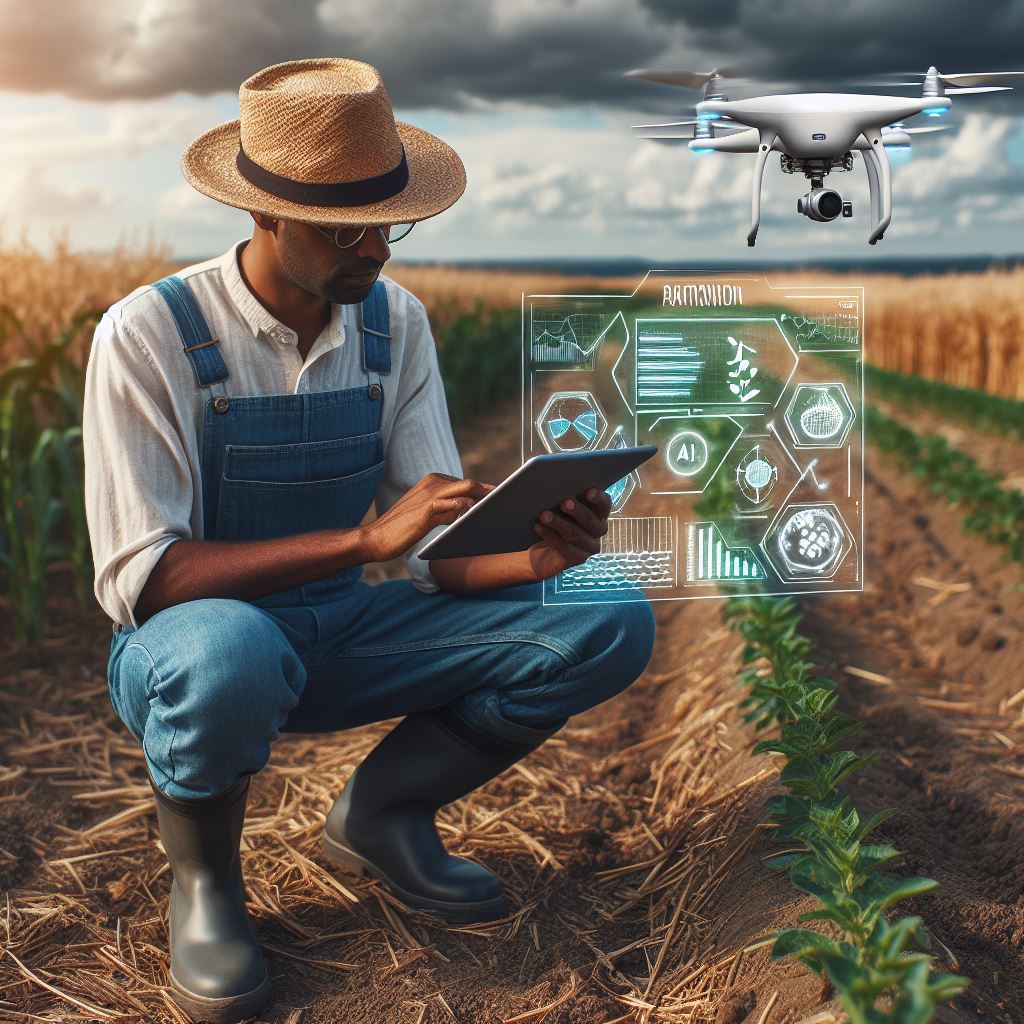AI in Agriculture: A Farmer’s Journey
Last Updated on February 28, 2024
Introduction
Exploring “AI in Agriculture Farmer Journey” we understand the importance of AI in modern agriculture.
AI in agriculture refers to the use of artificial intelligence technology in farming practices. It plays a crucial role in improving productivity, efficiency, and sustainability in the agricultural industry.
The purpose of this blog post is to explore the journey of a farmer in adopting and utilizing AI technologies in their day-to-day operations.
Through this narrative, we will delve into the challenges faced by farmers, the benefits of AI, and the future of AI in agriculture.
So, let’s embark on this captivating journey of a farmer embracing the power of AI to revolutionize farming!
The Beginning of the Journey
Background of the farmer
Meet John, a farmer from a small town in rural America, passionate about creating a sustainable future for his community.
Coming from a long line of farmers, John has always felt connected to the land and understands the importance of agriculture.
However, farming is not without its challenges. John faced numerous obstacles when he first started his journey.
Limited access to resources, unpredictable weather conditions, and the ever-increasing demand for food made it difficult for him to thrive as a farmer.
But then, John discovered the potential of AI technology in agriculture. He attended a farming conference where experts discussed the benefits and applications of AI in transforming the industry.
Inspired by what he learned, John decided to explore this new world.
John grew up in a small farming community, surrounded by vast fields and livestock.
As a child, he would often accompany his parents to tend to crops and care for animals. This early exposure instilled in him a deep love for agriculture.
After completing his education, John took over the family farm. He faced numerous challenges, from soaring input costs to fluctuating market prices.
But his determination and passion for farming kept him going, despite the hurdles.
John was eager to find innovative solutions to sustain his business and make a positive impact on the environment.
This passion drove him to attend the farming conference that would introduce him to the world of AI in agriculture.
Initial challenges faced by the farmer
When John first started his journey as a farmer, he encountered several obstacles. Limited access to modern farming technology hampered his ability to increase productivity and efficiency.
Additionally, the unpredictable weather patterns often affected crop yields, leading to financial strains.
Furthermore, John struggled to keep up with the ever-changing demands of the market and consumer preferences. He felt the pressure to adapt to new farming methods while maintaining traditional practices.
These challenges weighed heavily on John’s mind, making him question the sustainability and profitability of his farm. That’s when he realized he needed to explore alternative approaches to overcome these hurdles.
At the farming conference, John was introduced to the exciting applications of AI technology in agriculture.
AI, or Artificial Intelligence, is a branch of computer science that enables machines to learn and solve complex problems without explicit programming.
John learned that AI could be utilized in various aspects of farming, such as crop management, livestock monitoring, and predictive analytics.
Through AI, farmers could leverage data-driven insights to make informed decisions, minimize resource wastage, and optimize yields.
Introduction to AI technology
Excited by the possibilities, John decided to embrace AI on his farm.
He understood that by incorporating smart sensors, drones, and machine learning algorithms, he could revolutionize his operations, enhance productivity, and reduce environmental impact.
The beginning of John’s journey into AI in agriculture marked a turning point in his life.
Armed with newfound knowledge and a determination to adapt, John was ready to tackle the challenges ahead and create a sustainable future for his farm and community.
John’s journey into AI technology in agriculture began with a deep passion for farming and a desire to overcome the challenges he faced. The initial hurdles he encountered motivated him to explore innovative solutions.
Through AI, John discovered the potential for revolutionizing his farm’s operations, improving efficiency, and achieving sustainability.
The introduction to AI technology opened doors to a world of possibilities, and John was eager to embrace this new era.
In the next section, we will dive deeper into the specific applications of AI in agriculture and how John implemented these technologies on his farm.
Read: Montana Wheat: A Sustainable Farming Story
Exploring AI Solutions
To maximize the potential of AI in agriculture, it is crucial to research and understand the different AI applications available in this field.
By exploring various solutions, farmers can identify the specific problems on their farms that could benefit from AI.
Researching and Understanding Different AI Applications in Agriculture
When delving into the world of AI in agriculture, it is essential to conduct thorough research to gain a comprehensive understanding of the different applications available.
By doing so, farmers can determine which AI solutions are best suited for their specific needs.
The variety of AI applications in agriculture is vast, ranging from crop monitoring and yield prediction to automated irrigation systems and livestock management.
Each application serves a unique purpose and can greatly enhance the efficiency and productivity of farming operations.
For example, AI-powered drones equipped with sensors and cameras can provide real-time data on crop health, irrigation needs, and pest infestations.
This information allows farmers to make informed decisions and take timely actions to ensure the health and vitality of their crops.
Machine learning algorithms can also analyze historical data, weather patterns, and market trends to predict crop yields and optimize planting schedules.
By leveraging AI technology, farmers can make data-driven decisions that maximize their harvest and minimize waste.
Farmers can also benefit from AI solutions that focus on resource management, such as irrigation systems that adapt to weather conditions and crop requirements.
These smart-systems can optimize water usage, reduce costs, and mitigate environmental impact.
Identifying Specific Problems on the Farm that could Benefit from AI
Once farmers have a solid understanding of the various AI applications in agriculture, the next step is to identify the specific problems they face on their farms that could be addressed through AI technology.
Common challenges in farming include pest control, disease detection, soil health assessment, and labor shortages.
By pinpointing the areas that require improvement, farmers can effectively evaluate which AI solutions are most relevant and beneficial to their operations.
For instance, if a farmer struggles with pest infestations that affect crop yield, they can explore AI solutions like image recognition technology that detects and classifies pests in real-time.
By identifying infested areas promptly, farmers can take appropriate measures to mitigate the damage caused by pests.
Labor shortages are another significant problem faced by many farmers. AI-powered robots and automated machinery offer a solution by performing repetitive tasks such as planting, harvesting, and sorting produce.
This reduces the dependence on manual labor and increases overall productivity.
Additionally, AI can help monitor soil health by analyzing soil samples and providing recommendations for optimal fertilization and nutrient management.
By ensuring the soil’s fertility and health, farmers can enhance crop growth and yield.
Exploring AI solutions in agriculture involves extensive research and understanding of different applications.
By identifying specific problems on the farm that could benefit from AI technology, farmers can harness its potential to optimize their operations and improve overall productivity.
Implementing AI on the Farm
Decision-making process for implementing AI
- Farmers carefully assess their needs and identify areas where AI can bring value.
- They research and gather information on available AI technologies and their benefits.
- Cost analysis is conducted to determine the feasibility of implementing AI on the farm.
- Existing infrastructure and compatibility with AI systems are evaluated.
- The potential impact on the farm’s operations and productivity is thoroughly considered.
- Interactions with other farmers and industry experts help in the decision-making process.
Steps taken by the farmer to adopt AI technology
- The farmer starts by investing time in understanding AI and its potential applications.
- Training programs or workshops are attended to learn about AI technologies and their practical usage.
- The farmer considers the budget and selects the most suitable AI system.
- Implementation teams or AI experts are hired to ensure a smooth integration process.
- Infrastructure modifications, if required, are made to accommodate the AI technology.
- Data collection systems are set up to gather necessary information for AI algorithms.
- Farmers actively participate in AI implementation, adapting their workflow to leverage AI’s benefits.
Potential risks and considerations during implementation
- Data security and privacy concerns arise due to the collection and sharing of sensitive farm data.
- The need for reliable high-speed internet connectivity becomes crucial for AI operations.
- Initial investment and maintenance costs may pose financial constraints for some farmers.
- Technical difficulties and system failures might disrupt farm operations temporarily.
- Farmers may face resistance from traditional workers who fear job displacement.
- Integration of AI with existing farm management systems can be complex and require adjustments.
- Regular updates and upgrades are essential to keep AI technology efficient and effective.
In short, implementing AI in agriculture involves a decision-making process, steps for adoption, and considerations during implementation.
Farmers need to carefully assess their needs, research available options, and analyze costs before adopting AI solutions.
Steps such as learning about AI, selecting suitable systems, and modifying infrastructure contribute to successful integration.
Potential risks such as data security, technical difficulties, and resistance from workers should also be acknowledged and addressed.
By following a well-planned approach, farmers can leverage the power of AI to enhance their agricultural practices and achieve better outcomes.
Read: From Classroom to Field: Young Farmers’ Journey
Impact and Results
In the previous sections, we explored the transformative power of AI in agriculture and the challenges faced by farmers adopting this technology.
Now, let’s delve into the impact and results that AI has brought to the agricultural industry.
Improved efficiency and productivity on the farm
AI-powered technologies have revolutionized farming practices, allowing farmers to complete tasks more efficiently and increase overall productivity.
Drones and robots, equipped with AI, can perform various functions such as soil analysis, planting, irrigation, and monitoring crop health.
These automated systems not only save time and effort but also help prevent human errors.
Enhancements in crop yield and quality
AI algorithms can analyze data gathered from soil sensors, satellite imagery, and weather forecasts to provide valuable insights to farmers.
By considering variables such as moisture levels, temperature, and pest threats, AI models can optimize irrigation schedules, fertilization plans, and pest management strategies.
This results in healthier crops, reduced losses, and improved yields.
Reduction in labor and resources
AI technologies have significantly reduced the need for manual labor in farming operations.
With the introduction of autonomous vehicles, AI-enabled robotic arms, and automated machinery, farmers can accomplish tasks that previously required extensive human involvement.
By minimizing labor requirements, farmers can allocate their resources more efficiently and invest in other areas of their operations.
In essence, AI has had a profound impact on agriculture, revolutionizing farming practices and bringing numerous benefits to farmers and the industry as a whole.
Improved efficiency, enhanced crop yield and quality, and reduced labor and resource requirements are just some of the positive results that AI has brought to the farm.
As technology advances, the potential for even greater transformation in agriculture is immense.

Overcoming Challenges
In the journey of implementing AI in agriculture, farmers often face initial difficulties and steep learning curves.
Initial Difficulties and Learning Curve
Integrating AI into agriculture processes can be challenging initially as farmers may lack technical expertise.
Learning to operate AI-enabled systems and understanding complex algorithms can be time-consuming.
Adapting to new technology can lead to resistance from traditional farmers who prefer conventional methods.
Support Systems and Resources Utilized to Overcome Challenges
Farmers leverage support systems and resources to overcome the challenges they encounter on their AI journey.
Training Programs and Workshops
Farmers can participate in training programs and workshops provided by AI technology developers. These programs educate farmers about the functionalities and benefits of AI systems in agriculture.
Workshops help farmers gain hands-on experience, improving their competence and confidence in utilizing AI.
Expert Assistance and Consultation
Seeking guidance from AI experts and consultants enables farmers to navigate through challenges effectively. Experts can provide personalized advice based on the specific needs and circumstances of each farmer.
Consultation sessions help farmers understand the workflow and potential of AI in their agricultural operations.
Collaboration with Agricultural Research Institutions
Farmers collaborate with agricultural research institutions to access advanced AI technologies and expertise. These partnerships facilitate knowledge sharing, allowing farmers to tap into cutting-edge research and practices.
Research institutions can provide farmers with resources and support to optimize AI utilization in agriculture.
Continuous Improvement and Optimization
To overcome challenges, farmers embrace the concept of continuous improvement and optimization.
Analyzing Data and Performance
Farmers analyze data collected by AI systems to identify areas for improvement in their agricultural practices.
They evaluate the performance of AI algorithms, making necessary adjustments to enhance efficiency and productivity.
Data analysis helps farmers uncover patterns, trends, and insights to optimize decision-making in farming operations.
Feedback Loops and Adaptability
Creating feedback loops allows farmers to receive inputs from AI systems and make necessary adaptations. By iteratively improving based on feedback, farmers ensure the AI solutions align with their specific needs.
Adaptability strengthens the farmer’s ability to maximize benefits from AI and overcome emerging challenges.
Multidisciplinary Approaches and Knowledge Sharing
Farmers engage in multidisciplinary approaches, collaborating with experts from diverse fields.
Sharing knowledge and experiences with fellow farmers helps in finding innovative solutions to common challenges.
Collective intelligence enables continuous collective improvement and fosters a supportive farming community.
Basically, despite the initial difficulties and learning curve, farmers can overcome challenges in implementing AI in agriculture.
Utilizing support systems, resources, and continuously improving and optimizing the AI systems lead to success.
With determination and a proactive mindset, farmers can truly harness the potential of AI to revolutionize agriculture.
Read: Robotic Helpers: Changing the Farming Game
Lessons Learned
Key takeaways from the farmer’s AI journey
- Farming with AI can significantly improve efficiency and productivity.
- Proper data collection and analysis are crucial for successful implementation.
- Collaboration with AI experts and researchers can enhance decision-making processes.
- Continuous learning and adaptation are necessary to make the most of AI technology.
- Investing in the right AI tools and infrastructure is vital for long-term success.
Advice for other farmers interested in integrating AI
- Start small and gradually incorporate AI into specific areas of your farming operations.
- Consult with agricultural AI experts to identify the best solutions for your specific needs.
- Ensure data privacy and security measures are in place when dealing with sensitive information.
- Train and educate your workforce to effectively utilize AI technology.
- Monitor and evaluate the performance of AI systems regularly to optimize their efficiency.
Reflections on the overall impact on the farm’s success
The integration of AI in agriculture has revolutionized the way our farm operates, leading to remarkable success and growth.
Our experiences have taught us valuable lessons that have transformed the entire farming process.
By leveraging AI technology, our farm has achieved remarkable improvements in crop yield and quality.
The ability of AI systems to analyze vast amounts of data in real-time allows us to make more informed decisions regarding irrigation, fertilization, and pest control.
Generally, our journey with AI in agriculture has been transformative. The lessons we have learned, along with the advice we offer, can guide other farmers in their pursuit of integrating AI into their operations.
The overall impact on our farm’s success has been awe-inspiring, and we are excited to witness the continued advancements and innovations in this field.
Future Outlook
In the world of agriculture, the potential of AI technology is immense and holds promising opportunities for farmers.
As we progress into the future, AI adoption is expected to rise significantly, with the integration of advanced technologies in farming practices.
The Potential of AI Technology in Agriculture
AI technology in agriculture has the potential to revolutionize the way farmers approach their work.
With the ability to collect and analyze huge amounts of data, AI can provide valuable insights and recommendations for better crop management and improved yields.
By leveraging AI capabilities, farmers can gain a deeper understanding of their crops’ health, soil conditions, and pest infestations.
This knowledge enables them to make informed decisions regarding irrigation, fertilization, and crop protection, leading to more efficient and sustainable farming practices.
AI-powered drones and robotics are also transforming traditional labor-intensive farming methods.
These automated systems can perform tasks such as planting, harvesting, and monitoring crops, reducing the need for manual labor and increasing productivity.
Predictions and Trends in AI Adoption
As AI technology continues to evolve, its adoption in agriculture is expected to skyrocket. According to industry experts, the global AI market in agriculture is projected to reach a value of $2.6 billion by 2025.
One of the key trends is the increasing use of machine learning algorithms to analyze and interpret agricultural data.
These algorithms can identify patterns and predict crop yields, weather patterns, and market trends, assisting farmers in making informed decisions.
Another emerging trend is the development of AI-powered autonomous farming systems.
These systems combine various technologies, such as robotics, sensors, and AI algorithms, to automate farming operations and optimize resource utilization.
Opportunities for Further Innovation and Growth
With the rapid advancement of AI technology, there are numerous opportunities for further innovation and growth in the agricultural sector.
- One area with immense potential is precision agriculture. AI can enable farmers to precisely manage their resources, reduce waste, and increase productivity.
- By analyzing real-time data from sensors and satellites, AI algorithms can provide customized recommendations for optimal planting, applying fertilizers, and managing water usage.
- AI can also facilitate better disease and pest management.
- By monitoring crop health and identifying early signs of diseases or infestations, farmers can take proactive measures to prevent crop losses and reduce the need for pesticides.
- Furthermore, AI can contribute to sustainable farming practices and the conservation of natural resources.
- By optimizing resource allocation and reducing waste, farmers can minimize their environmental impact and ensure the long-term viability of their operations.
Generally, the future outlook for AI in agriculture is incredibly promising.
The potential of AI technology to revolutionize farming practices, predict market trends, and optimize resource utilization is vast.
With the increasing adoption of AI and continuous innovation, farmers can expect to witness significant improvements in productivity, sustainability, and profitability.
Read: Hawaii’s Coffee Farms: Embracing Sustainability
Conclusion
We have witnessed the farmer’s incredible journey with AI in agriculture. They started with skepticism, but soon realized the immense benefits it could bring to their farm.
From automated irrigation systems to crop health monitoring, AI has revolutionized farming.
As we wrap up this journey, it is essential to encourage other farmers to embrace technology. AI is not a threat but rather a tool that can aid in optimizing crop production, reducing labor, and minimizing waste.
By incorporating AI into their operations, farmers can secure a better future for themselves and the world.
In the end, AI in agriculture is about improving efficiency, sustainability, and productivity.
It empowers farmers to make informed decisions based on real-time data, leading to higher yields and better crop quality.
We have seen how AI can detect diseases early, predict weather patterns, and maximize yield potential. It is an ally that should be embraced for a more prosperous farming industry.
In closing, the journey of the farmer with AI in agriculture has been transformative. We must recognize the potential that technology brings to the field and encourage its adoption.
The future of farming lies in the hands of innovative farmers who embrace AI and its ability to create a sustainable and fruitful agricultural ecosystem.


